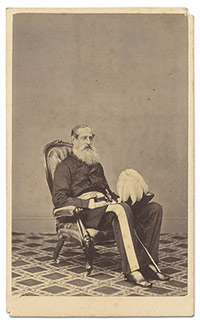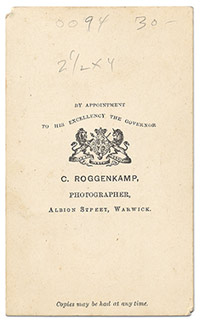Marking time in June 2012
A well-executed likeness
I just added to my little collection a carte-de-visite portrait of Colonel Samuel Wensley Blackall (1809-1871). Blackall was appointed Governor of Queensland in 1868, and died in office. In the photograph he sits in an arm chair with a sword between his legs and a feather hat on his knee. The setting is plain—there are no drapes, no columns, no furniture apart from the chair. The only decoration is the patterned linoleum on the studio floor.
It’s odd that he was photographed sitting down, rather than standing upright in a formal military pose as I would have expected for a governor’s portrait. Perhaps he was suffering from the illness from which he died. I don’t know what ailment caused his death, but I have read a suggestion it was something he caught in the tropics—he had been governor of colonies in West Africa and the West Indies.


The back of the card carries the line By appointment to his Excellency the Governor and the royal coat of arms, a nice counterpoint to the subject on the front.
Christopher Roggenkamp established his Warwick studio in 1868, and his brother Martin established another studio in Toowoomba in 1874. Some of Christopher’s descendants have also been photographers.
Christopher wrote this letter to the editor of a Toowoomba newspaper, The Darling Downs Gazette, which was published on 30 January 1878.
PHOTOGRAPHY AT WARWICK.—————
To the Editor of the D. D. Gazette,Dear Sir, — I do not know who your correspondent in Warwick is, nor do I care so long as he deals with public matters; but if he chooses to take for his subject private townsmen, it is time to point out that he will do you more harm than good. His letters at present are but the greatest twaddle, and a copy of the locals in the Warwick papers, but they can pass unnoticed so long as they do not affect the credit and standing of private townsmen.
The letter which appeared in your issue of Wednesday, the 18th inst., for instance, stated “that the modern improvements in the photographic art seem to be a long time in finding their way up this length.” Now, as I am the only one engaged in that line in Warwick, I take this as a deliberate and untruthful reference to me. I can assure you and your fault-finding correspondent that there are the most recent improvements in my gallery, and that I watch for any new invention as close as your correspondent ferrets out things to find fault with. I have had very high credit accorded to me for my work, and have been told, over and over again, that my photographs will bear comparison with those from the most puffed-up galleries in the large towns. As an instance, I enclose a few photographs (not picked) from the large number I have taken, and I will ask you to give your opinion of them publicly, after comparing them with those from other galleries.
It is not likely that I should have been patronised for fifteen years in Warwick by townspeople and residents of the district and visitors from all parts of the colony, as I have been, had my work not been approved of.
In conclusion, I may say that, if your correspondent chooses subjects of this sort, no townsman is safe from being run down and a slur cast upon him by someone who feels himself aggrieved.
I am, Sir,
Your obedient servant,
C. Roggenkamp.
Warwick, January 21st, 1878.
The newspaper editor added this gracious response:
[The photographs sent for our perusal are, as far as we can judge—not knowing the originals—good ones. Amongst them is a well-executed likeness of the late lamented Governor Blackall. Our correspondent states in the letter complained of, that “modern improvements are a long time in finding their way to Warwick.” Two of the latest improvements are, we understand, “embossing” and “enamelling”. Possibly our correspondent referred to these. Whether Mr. Roggenkamp has these improvements or not, neither of them are shown in the photographs sent us. However, there is a difference of opinion as to whether “embossing” and “enamelling” are improvements—many people preferring their cartes-de-visite plain. Leaving them out of the question, therefore, the photographs seem to us very well taken, the features in each one being brought out quite distinctly. They are certainly equal to any six or eight that might be picked out from more pretentious galleries.— Since writing the above Mr. Roggenkamp has telegraphed to us to the effect that he did not send “embossed” cards, as they get spoiled through posting,— Ed. D. D. G.]